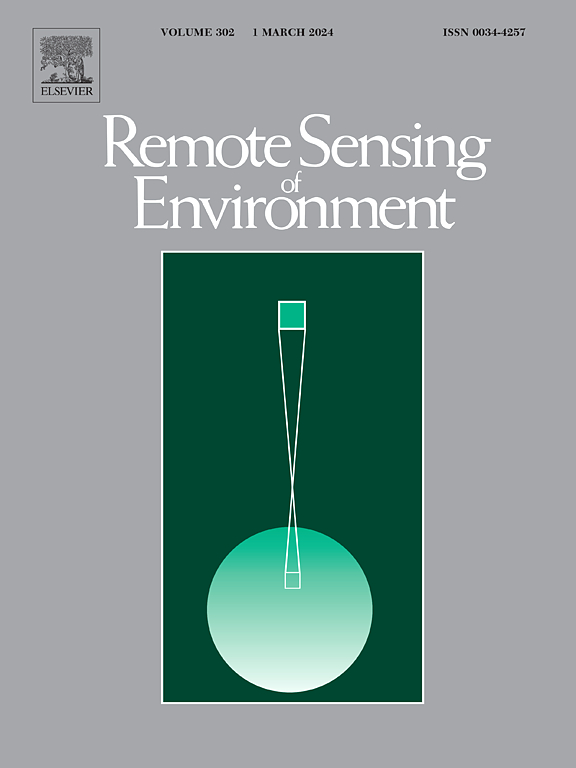STARS:一种利用时空和光谱协同作用的SDGSAT-1夜间灯光图像空白填充新方法
IF 11.1
1区 地球科学
Q1 ENVIRONMENTAL SCIENCES
引用次数: 0
摘要
可持续发展目标卫星 1 号(SDGSAT-1)配备了微光成像仪(GLI),提供多个光谱波段的高分辨率夜间光照(NTL)数据。因此,它能以更高的光谱和空间分辨率监测人类动态和光污染。然而,云层和低质量观测常常会污染 SDGSAT-1 GLI NTL 数据,从而限制了其有效性。为解决这一难题,我们开发了一种新方法,即用于 SDGSAT-1 GLI NTL 图像的时空和光谱填隙方法(STARS),该方法结合了时空和光谱信息,可生成像素亮度和连续性令人满意的无云 NTL 图像。STARS 是首个利用 RGB 光谱信息有效解决多波段 NTL 数据间隙填充问题的方法,即使在不规则的时间间隔和有限的图像输入情况下也是如此。与时间间隙填充法、平均加权间隙填充法、时空信息协同云去除法(CRYSTAL)和时空自适应反射率融合模型(STARFM)等传统方法相比,STARS 能有效解决多波段 NTL 数据的间隙填充问题、在对全球七个城市的模拟中,STARS 表现出了卓越的性能(更高的 R 平方(R2)和更低的均方根误差(RMSE)),证明了其在填补多波段 NTL 数据中由云层引起的空白方面的有效性。与 RGB 波段的实际值相比,STARS 的平均 R2 值分别为 0.79、0.78 和 0.70。STARS 生成的无云图像扩展了 SDGSAT-1 GLI NTL 数据的时间序列,支持多时定量分析。在中国天津等多云地区,STARS 有效捕捉到了春节前后 NTL 的动态变化,在空间和时间上都与百度地图上的人类活动模式密切吻合。总之,STARS 为填补多波段 NTL 数据的空白提供了一种创新而有效的方法,有望应用于类似的数据集。本文章由计算机程序翻译,如有差异,请以英文原文为准。
STARS: A novel gap-filling method for SDGSAT-1 nighttime light imagery using spatiotemporal and spectral synergy
The Sustainable Development Goals Satellite 1 (SDGSAT-1), equipped with the Glimmer Imager (GLI), provides high-resolution nighttime light (NTL) data across multiple spectral bands. Thus, it can notably monitor human dynamics and light pollution with enhanced spectral and spatial resolution. However, cloud cover and low-quality observations often contaminate the SDGSAT-1 GLI NTL data, limiting its effectiveness. This challenge is addressed by the development of a novel method, namely the SpatioTemporal And spectRal gap-filling method for Sdgsat-1 (STARS) GLI NTL images, which combines spatiotemporal and spectral information to generate cloud-free NTL images with satisfactory pixel brightness and continuity. STARS is the first method to effectively address gap-filling in multiband NTL data using RGB spectral information, even with irregular time intervals and limited image inputs. Compared with traditional methods such as the temporal gap-filling method and the mean-weighted gap-filling method, the Cloud Removing bY Synergizing spatioTemporAL information (CRYSTAL) method, and the spatial and temporal adaptive reflectance fusion model (STARFM), which do not specifically account for the differences in light source variations in multi-band NTL data, STARS demonstrates superior performance (higher R-squared (R2) and lower root-mean-square error (RMSE)) in simulations across seven global cities, demonstrating its effectiveness in filling cloud-induced gaps in multi-band NTL data. On average, STARS achieves R2 values for the gap-filling results compared to the actual values of 0.79, 0.78, and 0.70 in the RGB bands, respectively. The cloud-free images produced by STARS extend the time series of the SDGSAT-1 GLI NTL data, supporting multitemporal quantitative analysis. In cloudy regions like Tianjin, China, STARS effectively captures dynamic changes in NTL before and after the Spring Festival, closely matching human activity patterns from Baidu Maps, both spatially and temporally. Overall, STARS offers an innovative and effective approach for gap-filling multiband NTL data, with potential applications in similar datasets.
求助全文
通过发布文献求助,成功后即可免费获取论文全文。
去求助
来源期刊

Remote Sensing of Environment
环境科学-成像科学与照相技术
CiteScore
25.10
自引率
8.90%
发文量
455
审稿时长
53 days
期刊介绍:
Remote Sensing of Environment (RSE) serves the Earth observation community by disseminating results on the theory, science, applications, and technology that contribute to advancing the field of remote sensing. With a thoroughly interdisciplinary approach, RSE encompasses terrestrial, oceanic, and atmospheric sensing.
The journal emphasizes biophysical and quantitative approaches to remote sensing at local to global scales, covering a diverse range of applications and techniques.
RSE serves as a vital platform for the exchange of knowledge and advancements in the dynamic field of remote sensing.
 求助内容:
求助内容: 应助结果提醒方式:
应助结果提醒方式:


